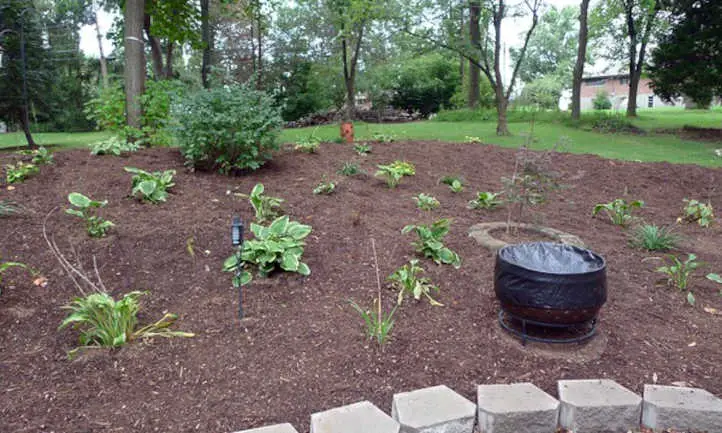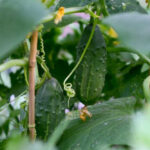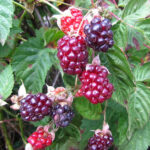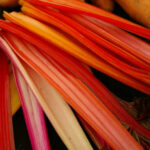An important part of gardening is knowing how to spread mulch. Whether you want to retain moisture with wood chips or protect the plants’ roots in winter with dead leaves, it’s great to know what works best in different situations. Knowing how much mulch to use helps too!
Mulching can be a late spring activity, or it could occur when you transplant a tree in late winter. Applying mulch has many benefits; one of the most common is keeping weeds at bay. There are other reasons to mulch a garden bed or yard. Applying mulch of the appropriate kind keeps plants healthy.
There are plenty of virtually free mulches out there. Add mulch to have varying effects on a garden bed. If you’re wondering how to go about adding and applying this incredible resource, we’ll cover step-by-step instructions throughout this guide.
Why Mulching Matters

Mulching has two basic functions: to lock in moisture and to keep weeds out. That’s because mulch acts as a barrier between the soil and the sun, preventing evaporation and the germination of weed seeds or existing weeds. Some mulch also breaks down over time, returning nutrients to the soil. Some break down faster than others. Spreading mulch may occur annually or monthly depending on what type you choose. Of course, there are situations where certain mulch is more appropriate than others. So before you lay mulch, consider the types at your disposal.
Applying Different Types of Mulch
If you’re worried spreading mulch could break the bank, worry not. There are plenty of mulch sources out there. Some are cheap or even free! First, you’ll need to peruse a list of mulch types and decide which is best for your needs. Let’s talk about how to apply it in varying contexts.
Organic Mulch
This overarching mulch category refers to organic materials that are spread on the soil to suppress weeds, keep the soil moist, and feed nutrients to plants. With these materials, you should mulch as often as you need to keep a good mulch depth in the area while avoiding overwhelming the garden soil therein.
Straw mulch is the dried stalks of cereal crops, like oat, wheat, or rice. Most people apply mulch made from dry cereal plants on their veggie garden because it breaks down quickly feeding plants as it decays. We have a great straw mulch product in our store, called HealthiStraw.
Wood chips are bought or delivered free by an arborist. They’re great for gardens with established plants and trees, and landscaping because they break down slowly and don’t need reapplication for several months at a time. Wood shavings are the byproduct of tree trimming and removal, or from horse stalls. Bark mulch is too.
Leaf mulch is usually free and collected by you or snagged from a neighbor’s yard. Leaves are chock-full of quality organic matter that will decompose into the soil, improving the soil and releasing nutrients.
Pine straw (or pine needles) is another virtually free resource for those who live near pine trees. Brown pine straw is generally not acidic and will decompose down into a lovely forest-like layer on the soil’s surface.
Collect grass clippings as you mow your yard in spring and mulch beds, or incorporate them into a compost pile. Clippings break down quickly and must be reapplied often.
Cocoa hull mulch is made from cocoa bean hulls and emits a chocolatey smell when wet. They’re a great choice for gardeners who want to add rich brown accents to their landscapes without using dyed wood mulch. But they’re not pet friendly, due to the source: chocolate and cacao products are not safe for dogs to eat.
Cardboard and newspaper can act as mulch layers when they’re shredded or laid down as a preliminary in a lasagna garden. It’s easy to gather newspaper and cardboard for free. Usually, they’re paired with another mulch type: compost.
Good composted materials may require a bit of a search before they’re found. Some options for compost include mushroom compost and other plant-based composts, composted cow manure, or composted horse manure. Remember that with these products, plants can grow directly in them, so it’s still best to use a few inches of wood chip to top off these materials.
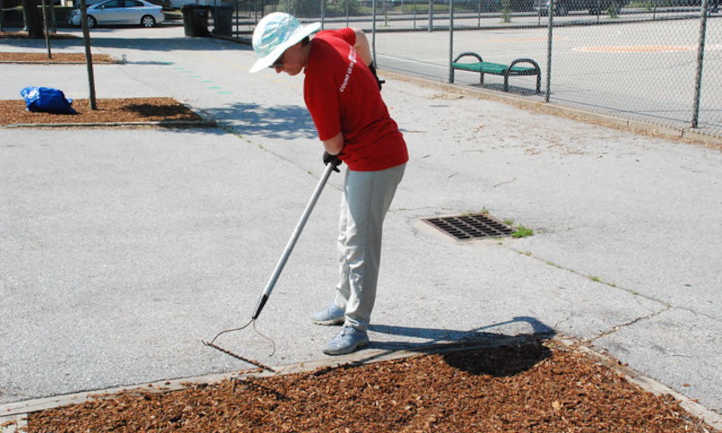
Inorganic Mulch
This mulch is made of materials that don’t break down over time. They still serve the dual purpose of removing weeds from a garden and locking in soil moisture. But they don’t need to be replenished in most situations, making them great for pathways and landscaping design. There are natural and man-made options for inorganic mulch as well.
Rubber and plastic mulch are both man-made mulches. Rubber is often the result of shredding industrial materials, like tires. Plastic mulch comes in sheets. For both types, apply the mulch in a layer over a garden for weed suppression. These can’t be used in lasagna gardening as they do not break down, and there are questions as to whether they leach risky materials into your soil, so these are best used in locations where you do not plan to grow anything such as pathways or children’s play areas.
If you’d like an inorganic mulch that’s naturally sourced, pumice rock or pea gravel are excellent choices. Not only do they do the basic mulch tasks, but they also act as the basis for a rain garden, channeling from an irrigation source. Both options look great in landscapes and are often employed in desert gardens and around xeriscape plants.
Preliminary Tasks
The first step in any mulching adventure is to calculate how many cubic yards of mulch you’ll need for a given space. 1 cubic yard covers a 324-square-foot area 1 inch deep. Use the following equation to determine the number of materials you need to gather or purchase. By knowing how much mulch you need, you’ll save yourself a lot of back and forth between your mulch source and the square footage of your garden.
Square footage x Desired Depth / 324 = Cubic yards needed
Prepare the space by removing any existing weeds and using a hoe, small rake, or aerator. This helps expose the surface of the soil to any materials that may break down and feed nutrition to the soil.
How to Spread Mulch For Lawns
To promote a healthy lawn and provide weed control throughout the year, apply mulch in spring. Mow your yard with a lawnmower that has a mulching blade. Cut no more than ⅓ of the height of the grass, and either allow it to lay on the yard or collect it to use in a more meticulous and controlled manner. Your collection process could involve a bag attachment on your mower, or you could rake the mulch into small piles to be spread later.
If you must cut more than ⅓ of the height of your grass and are worried about thatching developing at the root level, set your lawnmower at a taller height and cut excess growth back while using a mower bag. Do a second pass slightly lower without the mower bag to apply a smaller amount of mulch easier without going overboard. The material in the mower bag is ideal for composting or disposal. Too much mulch on a lawn can cause thatching when more than ½ inch of mulch is spread on the lawn surface. This also applies to newly sprouted lawns. Spread mulch to promote growth, not stifle it! Ensure you don’t spread too much mulch and prevent proper air circulation around growing grass.
You may have guessed that grass clippings are the best mulch for your lawn. Each clipping adds nutrient content to the lawn that will be a valuable resource over the next couple of months. Every time you mow in spring, reapply a thin layer of clippings to continually add the benefit that mulching provides. While leaf mulch can also be used here, it needs to be very finely chopped to prevent killing off grassy surfaces underneath, and it can create a thick thatch that would need to be aerated.
Best Mulch For A Non-Grass Yard
What if you aren’t trying to grow lush green grasses but instead want to reduce weed growth in a xeriscape or other style of yard landscaping?
In situations like this, arborist’s chips are our favorite solution. Arborist’s chips slow water evaporation, keeping the dirt from drying out or cracking. They also prevent erosion, and that can be a huge concern in dry landscapes like this. But they’re not the only solution; inorganic mulches like pea gravel or pumice rock are also quite effective and can look fantastic. Choose the option that’s best for your setting and future goals.
To spread arborist’s chips in the yard, make several short piles of mulch, then use the back of a bow rake to spread them to the depth you prefer. 4 to 6 inches of mulch will retard the majority of weed growth and maintain soil integrity.
How to Spread Mulch in a Raised Bed
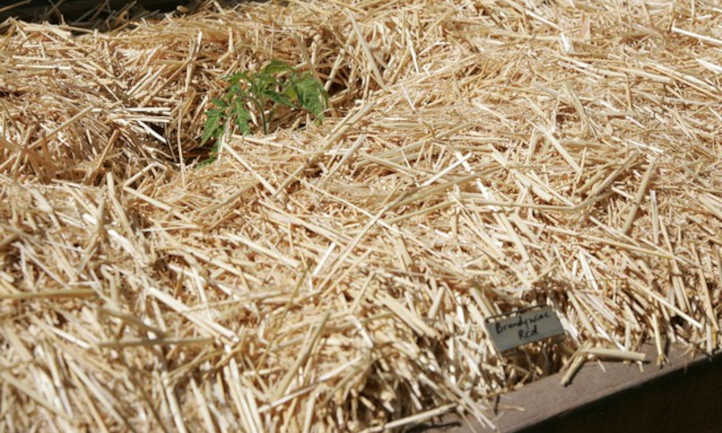
If you have a raised bed that has produced a lot over the years, mulching adds nutrients to the soil which may be tired from continuous production. It also aids in soil moisture retention and is a form of erosion control.
Before you plant again, determine the square footage of your raised beds to figure out how much mulch is appropriate. A thick layer of any mulch will take more time to break down than a thin layer. To apply mulch in the layers above the newspaper and/or cardboard, use a wheelbarrow and shovel, or simply use a bucket and spread with your hands. In larger beds, a rake is useful for layering soil amendments and mulch. And you might consider mulching before planting, too.
Alternatively, lay mulch thinly in an existing bed around established plants. Either pile mulch within the flower bed or veggie garden, and then spread it around by hand, or use a rake to spread it between plants. Ensure you don’t lay mulch directly onto plant stems, as this can prevent irrigation from getting to the roots. Instead, leave an inch or so between mulch and each plant.
While spreading mulch around plants is great for keeping out weeds and locking in moisture, mulch isn’t great for beds where young plants live. That’s because young plants need a lot of air circulation to develop strong root systems that produce healthy foliage.
Best Mulch for Raised Beds
For most raised beds, a combination of straw mulch, composts, and sometimes layers of newspaper or cardboard works best. Whether you use one, or a combination of all depends on the situation.
How to Spread Mulch in Built-in Garden Beds
Built-in beds not only benefit from the nutrition of organic materials spread 1 or 2 times annually, but they also gain aesthetic appeal in the process. Again, spread mulch either before planting established plants, or wait until the plants in the bed are mature enough to lay mulch. In this case, coarse mulch like hardwood mulch or pumice rocks is a great choice. It’s perfectly fine (and more ecologically focused) to add materials that you have around your yard, like leaf litter. Remember that organic materials feed nutrients to the soil while inorganic mulches do not.
Determine the square footage of your built-in beds (whether they are flower beds or vegetable-producing). Gather your garden mulch, whether that be dead leaves or leaf debris, pine needles, wood chips, or inorganic materials. Use a wheelbarrow or bucket to transport materials to the beds for mulching.
Create small piles of mulch around plants and shrubs, and cover the entire bed with the piled materials, leaving small spaces between the base of plants and the mulch. In a garden that is already established, a small rake is an excellent tool because it allows you to stand while you spread the mulch. A steel tine rake is a great tool for gathering leaves to put in your perennial beds or flower bed, too. If leaves are your go-to mulch, a leaf blower can help you pile them quickly.
Best Mulch for Built-in Garden Beds
Because built-in beds need weed control and moisture retention more than other beds, finely shredded wood chips are the best mulch source. Combine old mulch with tree litter from your front or backyard, like leaves and bark. One thing to consider is whether or not you’ve had issues with pests in the garden in the past. Insects can sometimes overwinter in leaves and bark from trees they’ve infested. Consider this when you spread the mulch in your annual beds and flower beds.
How to Mulch Around Trees
To mulch around trees, use wood mulches or leaves. Not only does shredded bark and tree debris keep out existing weeds, but it also prevents weed growth too. As the mulches break down around the base of the tree, the soil is improved and water is retained. Pine needles are an excellent alternative, especially around pine trees.
Calculate the amount of material needed to apply at least a 2-inch coat around the base of the tree. At most, apply 4-6 inches. Acquire the materials, and use a wheelbarrow or small receptacle to lug them about. Then shovel them in piles around the tree trunks, and rake the material into a sheet. Ensure at least a 6-inch gap is left between the tree trunk and the material. A steel tine rake is great for spreading materials. Reapply mulch annually.
How to Spread Mulch for Pathways
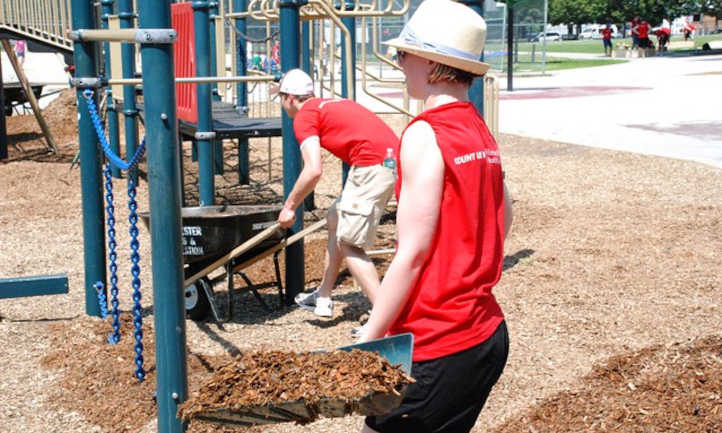
Because pathways should be weed-free, use some kind of barrier to keep them at bay. Landscaping fabric is most effective in this case, and it doesn’t break down as easily as newspaper or cardboard. The latter two are effective barriers as well, in place of landscaping fabric. Begin by marking out your mulched walkway. Level the ground with a shovel. After the ground is leveled appropriately, lay your barrier, and affix it if necessary with ground staples or rocks. Then apply your desired material in piles with a shovel, and rake it to an even layer. A good 6 inches makes for a cohesive pathway. While wood is a great material for pathways, something like pea gravel may add colorful accents. Wood is great for those who want to use old mulch in their compostables. More natural materials break down over time and must be reapplied for the same effect.
Barrier or No Barrier?
While a barrier makes a lot of sense in building pathways, it may not always be the best option. Especially in areas where beneficial insects can’t get to your shrubs and vegetables as a result of the barrier, avoid laying one. Often in areas where you’re already growing plants, a thick layer of mulch will adequately suppress weeds. While spreading mulch in a thin layer makes the most sense sometimes, that material can be your barrier instead of landscaping fabric, cardboard, or newspaper. So consider what the purpose of your garden is before you decide to lay a barrier.
Frequently Asked Questions
Q: What is the fastest way to spread mulch?
A: It depends on the situation, but spreading mulch is easiest with a bow rake. In smaller areas, hands work just fine.
Q: How do you prepare the ground before mulching?
A: Remove any weeds that exist in a bed, and aerate the garden surface.
Q: Is spreading mulch easy?
A: Absolutely! It takes very little time and effort to produce huge results.

